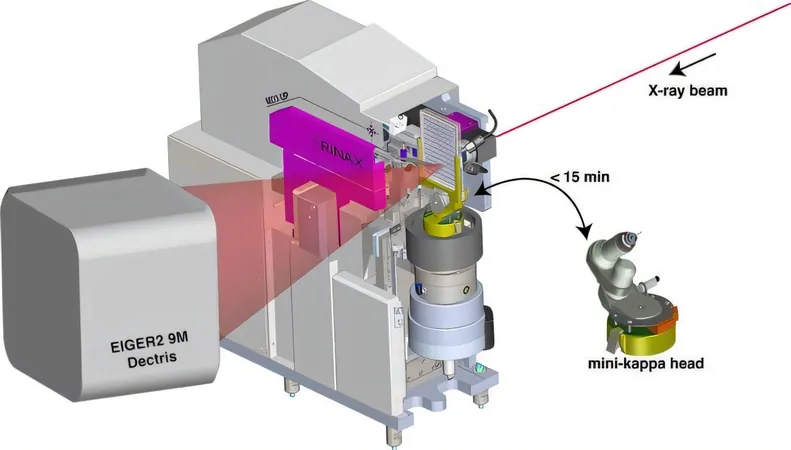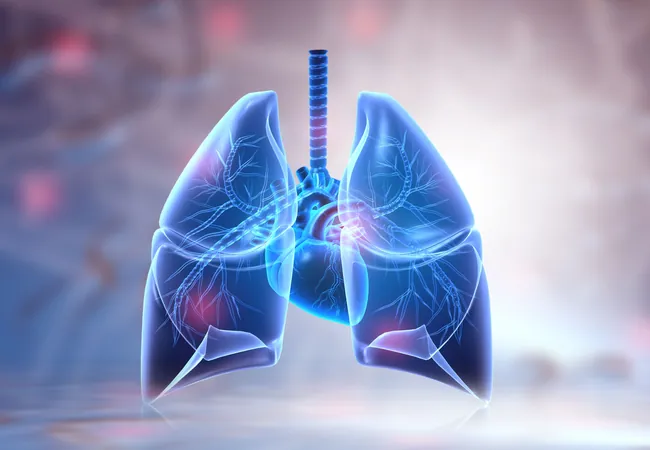
Breaking New Ground: Making In Situ Serial Crystallography Accessible for Scientific Breakthroughs!
2024-11-12
Author: Sarah
In an exciting advancement for structural biology, scientists from EMBL Grenoble and the European Synchrotron Radiation Facility (ESRF) have unveiled a groundbreaking method of in situ serial crystallography (iSX), allowing for unprecedented insights into the structures of macromolecules directly from crystallization plates.
This innovative technique was recently detailed in a study published in IUCrJ and is now operational at the ID23-2 beamline.
Meet the Innovator: Nicolas Foos
Leading the charge is Nicolas Foos, the first author and a key figure in the ARISE fellowship program, designed to propel the evolution of new technologies in life sciences.
With a Ph.D. in biochemistry and molecular biology from Université de Marseille and postdoctoral experience at prestigious synchrotrons like SOLEIL and ESRF, Foos is a driving force in advancing crystallography methods.
Revolutionizing the Crystallization Process
Traditionally, crystallography involves painstakingly harvesting the best crystals from a crystallization plate, which typically houses around 96 wells, each containing multiple micro-drops of protein crystals.
This conventional method is often labor-intensive and time-consuming. Foos and his team have changed the narrative by enabling direct screening of these crystals on the plate itself.
The newly developed setup employs a sophisticated micro-diffractometer and a specialized holder for SBS-96 plates.
This technical innovation translates to enhanced movement precision and data collection accuracy—two critical factors ensuring high-quality results.
Bringing Structural Biology into the Modern Age
The advantages of this new method extend far and wide in the realm of structural biology.
The shortened workflow not only saves time and reduces costs but is particularly advantageous for drug discovery processes.
Researchers can now screen compounds right from the crystallization plate, facilitating experiments at room temperature—essential for observing proteins in their natural, flexible forms.
This both improves data quality and streamlines the overall research process.
Furthermore, Foos envisions a future where automated experimental workflows will become the norm, leading to a completely autonomous "From the Plate to the 3D Model" pipeline—eliminating the room for human error and enhancing efficiency!
A Vision for Accessibility in Crystallography
Foos's ambitions go beyond mere technological advancements.
His involvement in the ARISE fellowship aims to democratize the use of X-ray crystallography, making it accessible to a broader scientific community, including those less experienced in crystallography.
He believes that this innovation is a pivotal step toward the integration of crystallography into a more extensive "integrative biology" toolbox.
What Sets the ARISE Fellowship Apart?
Foos praises the ARISE program's comprehensive training, emphasizing the necessity of meticulously defining project parameters like scientific goals, technical bottlenecks, and collaboration strategies right from the application stage.
One unique facet of the fellowship is its mandate for secondments—providing essential work experience within partner organizations such as ESRF and commercialization avenues like ARINAX and ALPX.
These opportunities create a unique fusion of academia and industry, driving innovation and fostering interdisciplinary collaboration.
A Bright Future for Structural Biology
With innovative advancements like in situ serial crystallography and programs like ARISE pushing the boundaries of scientific research, the future of structural biology looks incredibly promising.
As more scientists gain access to these tools, we can expect a new wave of discoveries that could unlock mysteries of biology previously deemed too challenging to tackle.
The integration of better methodologies and the collaboration between various scientific disciplines ensure that we are on the precipice of scientific breakthroughs that could change the face of medicine and biotechnology!




 Brasil (PT)
Brasil (PT)
 Canada (EN)
Canada (EN)
 Chile (ES)
Chile (ES)
 España (ES)
España (ES)
 France (FR)
France (FR)
 Hong Kong (EN)
Hong Kong (EN)
 Italia (IT)
Italia (IT)
 日本 (JA)
日本 (JA)
 Magyarország (HU)
Magyarország (HU)
 Norge (NO)
Norge (NO)
 Polska (PL)
Polska (PL)
 Schweiz (DE)
Schweiz (DE)
 Singapore (EN)
Singapore (EN)
 Sverige (SV)
Sverige (SV)
 Suomi (FI)
Suomi (FI)
 Türkiye (TR)
Türkiye (TR)